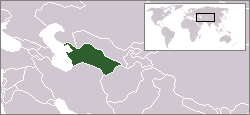Turkmenistan
Turkmenistan is a country in Central Asia with a population of about 5 million, and an area around half a million km2, or almost the size of Spain. Neighbouring countries are Iran and Afghanistan to the south, and Uzbekistan and Kazakhstan to the north. It has a coast on the Caspian Sea, but is otherwise landlocked. Nearly 80% of the country is part of the Karakum Desert.
The government is in firm control of nearly everything, although, surprisingly, tourism is welcomed as long as you don't discuss politics or the omnipresent police or military. The cult of personality the previous president created for himself is truly amazing and reminders of the Turkmenbashi's legacy are everywhere.
The traditional life of the Turkmen is that of nomadic shepherds, though some have been settled in towns for centuries. The country is known for its fine carpets (one is even featured in its flag) and horses. It is a fairly poor country that has been isolated from the world. Other than that, billions have been spent on modernization in Ashgabat, Turkmenbashi, and many other cities in post-Soviet times. And also, the country has extensive oil and gas reserves being developed, with pipelines to China, Iran, and soon Azerbaijan. Turkmenistan is also the second wealthiest country in Central Asia.
Regions
While the provinces are a helpful way to break down large Turkmenistan into regional travel areas, there is one geographical region present throughout them all, dominating the country—the brutal desert wasteland that is the Karakum.
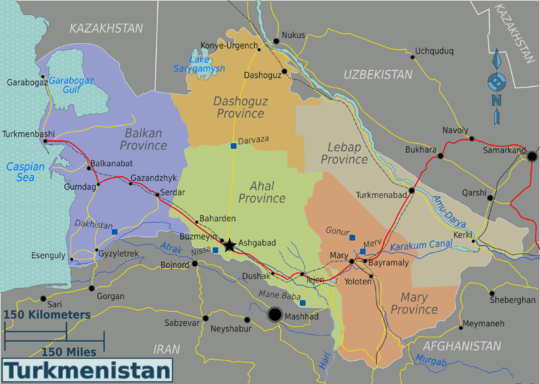
| Ahal Province The central region of the country, home to the capital. |
| Balkan Province The western province in the Caspian Basin. |
| Dashoguz Province Northern Turkmenistan, home to the historic city of Konye-Urgench |
| Lebap Province The eastern province, largely empty, along the Amu Darya River and the border with Uzbekistan |
| Mary Province Turkmenistan's southeast is a principal destination for travelers to see the ancient Silk Road capital of Merv. |
Cities
- 🌍 Ashgabat, the capital (2004: 727,200 inhabitants)
- 🌍 Balkanabat (formerly Nebit-Dag) (2004: 140,000 inhabitants)
- 🌍 Daşoguz (formerly Tashauz) (2004: 210,000 inhabitants)
- 🌍 Mary (2004: 160,000 inhabitants)
- 🌍 Türkmenabat (2004: 256,000 inhabitants)
- 🌍 Turkmenbashi (formerly Krasnovodsk), a Caspian port (2004: 86,000 inhabitants)
Historically, most of these towns were oases along the Silk Road.
Other destinations
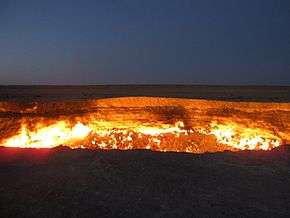
- Avaza – a multi-billion-dollar construction project near Turkmenbashi aimed at creating a "national touristic zone" of over 60 world-class hotels, shopping, and a new international airport. The government likens the project to Dubai, but there is little foreign investment thus far.
- 🌍 Darvaza – Probably Turkmenistan's single most famous site, at this spot near the former town of Darvaza, an oil rig accidentally struck a large pocket of natural gas in 1971. The rig collapsed into the cavern, resulting in a large crater filled with fire. It was decided to let the fire burn rather than let the poisonous gas escape into the nearby town. The fire burns to this day and it is popular as being easily mistakable for the gates of Hell.
- Pay a visit to Kow Ata underground sulphur lake, found in the mountains an hour or so outside Ashgabat. It is possible to swim in the year-round warm, mineral rich, and medicinal waters. Expect a walk down increasingly slippery steps, and a corrugated shack to change in - unless you're handy with your towel. Kow Ata means Father of the Lakes. The cave is more than 200 m long, 20 m high and at some point more than 50 m wide. The water has a constant temperature of 33 to 37 °C.
Archaeological sites
Medieval monuments
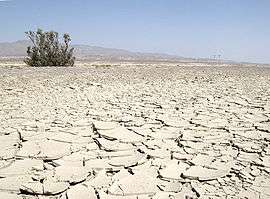
- Abiverd, medieval city (10th to 18th century)
- Abu Said Mithkene Mausoleum (11th to 15th century)
- Astana-baba, 15 km from Mount Atamurat, country estate of Omar-Kali with mausoleum and mosque
- Dayakhaty, near Turkmenabad, caravan serai (11th century)
- Darganata, medieval city, mausoleum (11th to 15th century)
- Dekhistan, historical area in Western Turkestan, big Mashat cemetery, Shir Kabir Mausoleum (10th century), ruins of Missirian city (10th to 15th cent.)
- Devkesengala, north west of Konye Urgench, fortress, mausoleums,
- Ekedeshik, near Tagtabazar, near the Afghanistan border, about 245 km south of Mary, cave settlement with more than 40 rooms, dating back to the Early Middle Ages, eventually a Buddhist monastery
- 🌍 Geok-tepe, place of a bloody battle between Turkmen and Russians in 1881,
- Imukshir, near Tara, ancient city, fortifications
- 🌍 Konye Urgench, remains of the capital of Horezmshah with magnificent architectural monuments,
- Mane Baba Mausoleum, about 40 km south of Tejen in the Khaka region. The mausoleum was built in the 11th and 12th centuries over the grave of the famous Sufi teacher and philosopher Abu Said Maneyi (968-1049). The legend tells that Abu Said met Abu Ali Ibn Sina (Avicenna) for a conversation that lasted three days. Afer this conversation Abi Said said: 'Ibn Sina knows everything that I see' and Ibn Sina answered: 'Abu Said sees everything that I know'.
- Parau, medieval settlement, Parau-bibi and Parau-ata (12th century)
- Sarakhs, ancient city with the Mausoleum of Abul-Fazi ("Sarakhs-baba" and Yarti-Gummez
- Seyitdzhemaledin Mosque, masterpiece of Muslim architecture (15th century)
- Shakhsenem, medieval settlement, mosque
- Talkhatan-baba, 30 km west of Mary, mausoleum (12th century)
- Tasharvat, 38 km west of Balkanabat, big medieval fortress
Nature reserves
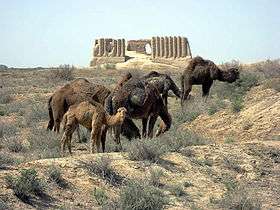
- Köpet Dag Nature Reserve in the mountains near Ashgabat
- Syunt Hasarday Nature Reserve in the mountains south of the Ashgabat-Turkmenbashi road,
- Esenguly Nature Reserve on the Caspian Sea near the border to Iran
- Krasnovodsk Nature Reserve on the Caspian Sea south of Turkmenbashi,
- Gaplangyr Nature Reserve in the Karakum Desert.
- Quzilqum Nature Reserve along the Amu Darya on the border to Uzbekistan,
- Amu Darya Nature Reserve along the Amu Darya on the border to Uzbekistan, north of Turkmenabat.
- Repetek Nature Reserve in the desert on the road between Mary and Turkmenabat,
- 🌍 Kugitang Nature Reserve in the mountains in the south east of the country on the border to Uzbekistan.
You will need a special permit in order to visit a nature reserve, and it will be necessary to apply for it through a travel agent well in advance.
Pilgrims' shrines
Shrine pilgrimage (ziyarat) and its underlying beliefs have played an important role in islamization of Central Asia as well as in creating and sustaining communal identity up to the present day. Recent research suggests that Musilm "holy men" (Sufi shaykhs) were key players in the conversion to Islam due to their knowledge of Inner Asian pre-Islamic religious traditions and their ability to translate the meaning of Islam to the local population. The prominent position of ancestor worship in Turkmen traditions is shown by the fact that the progenitor of a tribe or community is often ascribed to "islamizers" among the Turkmen. The burial sites of these Muslim founding fathers became a focus of veneration and were accompanied by what is called "Muslim shamanism": ancestral spirits were identified with the companions of the "Saint-progenitor". The communities also accepted saints with outstanding spiritual, intellectual or physical powers. Thus the burial sites of Islamic saints, local rulers, learned scholars, warriors or pre-Islamic figures have become shrines. Turkmen tradition also recognizes six non-Turkmen öwlat groups, which trace their lineage to the first caliphs of Islam, e.g. the progenitor of the öwlat group Ata is Gözli Ata who in the 14th century came from Turkestan, a center of Sufi teaching, in order to carry on his teachings in Western Turkmenistan. The legends describe him as an extremely powerful saint, outdoing other saints in miracle performances and winning large numbers of followers.
- Ak Ishan
- Gözli Ata, about 160 km north of Balkanabat. Gözli Ata ("Father Eye") was a famous Sufi teacher of the 12th century. It is told that he was able to recognize the good and the evil in the soul of all men. He was killed by the Mongols and buried here, next to his wife Bibi Aysulu.
- Ibrahim Sultan
- Ismamut Ata
- Kyrk Giz, in a spectacular caynon in the Kugitang Nature Reserve
- Kyrk Molla at Konye Urgench
- Malik Baba
- Mohammed Ibn Zaid Mausoleum
- Nedjmeddin Kubra Mausoleum at Konye Urgench
- Parau Bibi Shrine, about halfway between Ashgabat and Balkanabat, about 20 km north west of Gyzylarbat and about 8 km south of the main road, in the village of Paraw. The shrine is set 100 meters up a rocky mountainside overlooking the village and the steppe. It consists of a white mausoleum-like structure, a guest house and a roofed platform where the pilgrims congregate and have meals. According to the legend Paraw Bibi was a beautiful and virtuous maiden. A jealous woman wanted to hand over Paraw Bibi to invaders in exchange for the promise not to attack the village. Paraw Bibi cursed the woman and let her turn into black stone. When the enemy attacked, Paraw Bibi ordered the mountain to split into two parts so that she was able to enter it and to preserve her purity and virtue. The locals built a shrine to Paraw Bibi, as they believed that because of her bravery and refusal to submit she was a true hero blessed by the holy breath of the prophets. It is reported that at least at the end of the Soviet era pilgrims from all over western Turkmenistan visited the shrine, seeking fertility and a cure from insanity.
- Shibly Baba
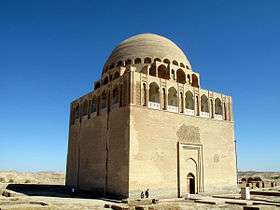
- Khoja Yusup Baba (Hemedani) is a large complex in southeastern Turkmenistan near Bairam Ali, on the territory of the ancient state of Merv. Khoja Yusuf Hamadani is a well known figure in Islamis history. He is considered as the first in a line of Sufi masters from which the lineages of the most important Sufi orders Naqshbandi and Yasavi are derived, and is described as an exemplary Muslim, pious and unpretentious, devoted to Islamic scholarship and deeply inspired by his work to promote Islam. He died in 1140 and his body was interred at Merv, presumably at the site carrying his name. In the Soviet era the Moseque of Khoja Yusup Baba was declared an official architectural monument and one of the four official mosques in entire Turkmenistan. It is popular belief that two pilgrimages to Khoja Yusup Baba equal one to Mecca. The pilgrims circle the tomb from right to left, surrounding the tomb three times. Most people repeatedly touch the wall of the tomb with both hand and bring their hands to the face. Some even kiss the wall. After they had completed the circling they sit together while the caretaker recites a blessing. When the blessing os finished they give the caretaker offerings of money. In the complex is a well said to contain holy water. Women tie small strips of cloth on the branches of the bushes or trees that line the path leading to the well. These strips signify prayers or wishes to the saint. For the same reason pilgrims set up two old bricks in the form of an upside-sown "V". Miniature imitation cradles made from sticks and cloth are set up by women hoping for the saint's aid in order to become fertile.
- Baba Gambar has several shrines. The best known is in southeastern Turkmenistan, about 120 km south of Mary: it is often considered as an example how a pre-Islamic deity was transformed into an Islamic saint. According to Islamic legend Ganbar was the stableman of Ali and caretaker of his horse Duldul. In Turkmen legends Ganbar is considered as the patron of musicians and creator of the first dutar, the traditional two-string music instrument. According to the legend Ali remarked that Duldul was ill and underfed. When he questionned Gambar, Gambar did not give an answer. Then, Ali saw Gambar playing the dutar to Duldul. When Ali confronted Gambar, Gambar commanded the earth to swallow him and fled underground to Mecca, saying that the two will meet again on judgment day. The site consists of the shrine-mausoleum, a "chile agach" and a tree the leaves of which have the shape of dutar tuning pegs. It is claimed that the tree grew from Gambar's original dutar and that its roots lead to the underground passage through which Gambar fled.
- Hazret(i) Ali is about 12 km southwest of Ashgabat, near the village of Bagir and the archaeological site of Nisa. The small mosque, called "namazga" (hall of prayer), is considered as a place where Ali prayed when he was promoting Islam. Impressions in the rocks are said to have com from Ali's hands and from the hooves of his horse Duldul.
- Khoja Alem Baba is near the town of Kaka, about 130 km south east of Ashgabat. It is an excellent example of a small, local shrine, serving one specific village only due to "öwlat" (clan lineage). The tomb is housed in a clay mausoleum with two chambers, an entrance or sitting area and the tomb chamber proper. Tomb and chamber are decorated with votive offerings and objects connected with Khoja Alem Baba. Sites as Khoja Alem Baba are very common in Turkmenistan. Apparently Turkmen tradition stipulated that each community has an "öwlüya" and by this way has access to the protection provided.
Understand
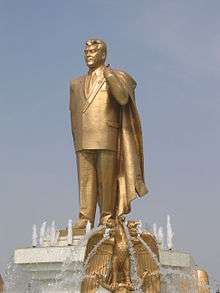
North Korea may get all the press, but even Kim Il-sung's cult of personality fades when compared to the surreal totalitarian state set up by Turkmenistan's former all-powerful President for Life Saparmurat Niyazov. He adopted the title Turkmenbashi ("Father of All Turkmen"), named the city of Turkmenbashi (formerly Krasnovodsk) after himself, and built a 15-m-tall golden statue that rotates to face the sun in the capital Ashgabat. The month of January was renamed Turkmenbashi after himself, while the month of April and the word "bread" became Gurbansoltan Eje, the name of Niyazov's mother. Decrees emanating from Niyazov's palace have banned, among other things, lip synching, long hair, video games and golden tooth caps. Through it all, Serdar Saparmurat Turkmenbashi the Great (his official title) pretended to remain modest, once remarking that "I'm personally against seeing my pictures and statues in the streets - but it's what the people want". Niyazov's government also spent billions in renovating the country, shut down libraries and hospitals, and even wrote the Ruhnama, a spiritual book to improve the Turkmen people.
Since Niyazov's abrupt if unlamented death in December 2006, his successor Gurbanguly Berdimuhamedov has slowly peeled back the worst excesses of the Turkmenbashi. The Ruhnama has lost its popularity, Berdimuhamedov has continued in the process restoring pensions and old names, while cementing on his own slightly more subdued cult of personality.
One thing of importance to any visitors who smoke cigarettes or cigars: it is forbidden to smoke 'in a public place'. Generally, this means 'outside'. Smoking at any of the bazaars is a definite no-no, as there were two major bazaar fires in 2006-2007. While it bothers non-smokers, those who enjoy tobacco products can enjoy them inside most restaurants, cafes, and nightclubs. A good rule of thumb - if you don't see anyone else smoking, you shouldn't. The government has also banned the sale of all tobacco in the country.
People
The people of Turkmenistan are predominantly Turkmen, also spelled Turkoman, in both ethnicity and language. Turkmenistan traditionally was home to sizeable Russian and German populations, but they largely emigrated to their mother countries following the break up of the Soviet Union. According to the 1995 census 77 percent of the population are Turkmen, 9 percent Uzbek and 7 percent Russian.
According to the Ruhmana, the Turkmens originated from Oguz Han and all Oguz people descend from Oguz Han's 24 grandsons. The original homeland of the Oguz tribes was the Ural-Altay region of Central Asia. The Orhun inscriptions (6th century) mentions the "six Oghuz tribal union", referring to the unification of the six Turkic tribes. This was the first written reference to Oghuz, dated to the period of the Göktürk Empire. The Book of Dede Korkut, the historical epic of the Oghuz Turks, was written in the 9th and 10th century. They migrated westwards in the area of the Aral Sea and the Syr Darya Basin in the 10th century. A clan of the Oghuz, the Seljuks took over Islam, entered Persia in the 11th century and founded the Great Seljuk Empire. The name Oghuz is derived from the word 'ok', meaning 'arrow' or 'tribe' and an archer shooting an arrow was shown on the flag of the Seljuk Empire. The term Oghuz was gradually supplanted by the Turks themselves by Türkmen or Turcoman. This process was completed in the 13th century.
The main tribes of the Turkmen are the Tekke (around the oases of Ahal, Tejen and Merv), the Ersari (along the Amu Darya), the Yomud (in the Balkan Region and Khorzem Oasis) and the Goklen in the Southwest.
Terrain
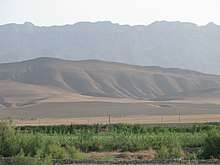
Turkmenistan is largely covered by desert, with intensive agriculture located in irrigated oases. One-half of its irrigated land is planted with cotton, making it the world's tenth largest producer.
About 80% of Turkmenistan's surface is covered by the biggest desert in Central Asia, the Karakum (Black Sand), which forms together with the Kyzylkum (Red Sand) in Uzbekistan the fourth biggest desert in the world. The Karakum covers about 350,000 km².
The Kopet Dagi Mountains (Many Mountains) in Southern Turkmenistan form the border to Iran. In the Kugitang Mountains in North East Turkmenistan is the highest mountain of the country, the Airbaba (3,117 m). The lowest point of the country is the Akdzhak depression, 80 m below sea level.
The country measures about 1,100 km from west to east and about 650 km from north to south.
Holidays
- 1 Jan: New Year
- 12 Jan: Remembrance Day (Battle of Geok Depe)
- Feb 19: National Flag Day (Birthday of Saparmurat Niyazov)
- Mar 8: Women's Day
- March 21–22: Nowruz (Navrouz: Spring festival)
- First Sunday in April: Drop of Water is a Grain of Gold Day
- Apr 27: Ahalteke Horse Day
- May 9: Victory Day
- May 18: Day of Revival and Unity
- May 19: Holiday of Poetry of Magtymguly
- Last Sunday in May: Turkmenhaly bairamy - Carpet Day
- Second Sunday in August: Melon Festival
- Oct 6: Remembrance Day (to remember the earthquake of 1948)
- 27 and 28 Oct : Independence Day
- First Saturday in Nov: Health Day
- 17 Nov: Student Youth Day
- Last Sunday in Nov: Harvest Festival
- 30 Nov: Bread Day
- First Sunday in Dec: Good Neighbourliness Day
- 12 Dec: Neutrality Day
Climate
Turkmenistan has a continental climate with long hot summers. Winters are not too cold. The average temperature is 26-34°C in summer and -4°C to 4°C in winter.
However, in northern regions the temperature in winter months can decrease to -20°C.
Read
- The Lost Heart of Asia by Colin Thubron, Penguin, 1994
- Daily Life in Turkmenbashy's Golden Age by Sam Tranum
- Joe & Azat by Jesse Lonergan
Get in
Entry requirements
All nationalities need a visa to enter Turkmenistan. For independent travel, a short transit visa can be obtained, but a full visa may be difficult. Most border guards are young conscripts and a small bribe can ease your entry at the border and roadblocks.
Arranging a tour will make things much easier, as the company can help in getting the Letter of Invitation and visa. You might well have to be met by a guide, regardless of how you enter Turkmenistan. This can be particularly important, especially if your inward journey is delayed as is possible when entering across the Caspian Sea by boat.
When you enter Turkmenistan your bags usually will be searched with an X-ray machine. You will have to fill a green Entry Travel Pass, an immigration card and a customs declaration. List all your valuables that you bring with you in the customs declaration, make sure that it is stamped and keep a copy with you. You will have to show it again when you leave the country.
Vaccinations
The World Health Organization recommends vaccinations against diphtheria, hepatitis A and B, measles, mumps, polio, rubella, tetanus, typhoid and chickenpox (varicella). In addition, vaccinations against meningitis, rabies and tuberculosis are recommended for long term travellers.
Visa

It is strongly recommended that you apply for a Turkmenistan visa before travelling to Turkmenistan. It is reported that travellers applying for visa at Ashgabat airport have been detained in the transit area of the airport for several days due to missing documents.
Registration
All foreigners entering Turkmenistan have to pay a registration fee of US$12 (2012) and will receive a green entry and departure card. Take particular care of the departure card, as it must be presented when leaving the country.
Foreigners staying for more than 3 days in Turkmenistan must register with IVOR in Ashgabat, Asady köcesi, phone 391337 or with IVOR branch offices in other towns. You are responsible for registration, even when staying in a hotel. The hotel will give you a confirmation of the accommodation only. This confirmation and the receipt for the registration fee paid when entering the country have to be presented to IVOR. Two photos are required. Registration will be stamped into your passport. You have to give notice to the IVOR in order to be permitted to leave the country. This notice will be stamped into the passport as well. Border controls will check if you have registration and notice to leave stamped into your passport.
Travel permits
Travel permits are required for many border regions. You do not need a travel permit for Ashgabat, Merv, Turkmenabat and Balkanabat. Transit visas allow you to travel along the main roads on your way to the next country on your itinerary. It is, however, absolutely necessary to have a travel permit for the following regions:
- in Western Turkmenistan: for Bekdash, Turkmenbashi, Haza, Dekistan, Yangykala, Gyzletrek, Nokhur and surroundings,
- in Northern Turkmenistan: for the entire region of Dashogus including Konye Urgench, Dargan-Ata and Gazachak,
- in Eastern Turkmenistan: for Farab, Atamurat (Kerki) and surroundings, Kugitang Nature Reserve, Tagtabazar and Serkhetabat.
By plane
.jpg)
Turkmenistan Airlines has direct flights to Ashgabat from Abu Dhabi, Almaty, Amritsar, Bangkok, Beijing, Birmingham, Delhi, Dubai, Frankfurt, Istanbul, Kiev, London, Minsk, Moscow, and Saint Petersburg. Look out for the portrait of Sapamurat 'Turkmenbashi' Niyazov at the front of the cabin. The schedules are often less-than-convenient, and there is no website for the airlines with flights listed. It's usually best to visit the webpage of the airport from which you are departing to find the schedule.
Turkish Airlines flies to Ashgabat from Istanbul. Lufthansa flies from Frankfurt to Ashgabat. See Ashgabat page for more detailed information. FlyDubai offers service from Dubai to Ashgabat.
By train
Virtually impossible. No official international trains exist and the only train (Moscow-Dushanbe) that transits the country is virtually inaccessible unless you are a Tajik citizen. Turkmenistan does not issue transit visas "from-then-again-to Uzbekistan" and one would need a standard non-transit visa (Tajiks don't need any papers for transiting Turkmenistan with this train). This train has no official stops on the Turkmen territory but it physically runs via Amudarya, where (if it accidentally stops) one could change to a Turkmen train towards Ashgabat.
By car
If you want to enter Turkmenistan with your own car, you need a liability insurance. The green International Insurance Card is not valid in Turkmenistan. In addition you have to pay an additional tax (about US$150) for the government subsidized fuel prices, depending on the distance of your travel in Turkmenistan. This tax has to be paid on the border in US dollars. Be prepared to have long waiting times at border controls. By vehicle, you can get in through Kazakhstan, Iran, Uzbekistan and Afghanistan.
The road from Kazakhstan to Turkmenistan is in terrible condition. If you don't have an SUV, the drive from Zhanaozen to the border may take up to 3 hours. Traffic is not permitted to cross these borders until further notice; the FCO advises those driving go via routes in Uzbekistan. The drive from the border to Garabogaz may take another 3 hours. Make sure to bring enough supplies since the border post is really isolated. Paperwork may take a long time but everything is very straightforward and people are really friendly and helpful. Very few tourists cross this border.
By bus
.jpg)
Visitors holding visas can enter Turkmenistan from all neighbouring countries. Checks at the border usually take one or two hours and maybe even more. Border points are open daily from 09:00 to 18:00.
From Iran
Since no public transportation goes across the Turkmen border, to get to Ashgabat in Turkmenistan from Mashhad (Iran), the following option is the most convenient:
- Take a bus to Quchan: every 2 hours from 06:30. Cost: 8000 rial. Duration: 2hr 30min.
- From Quchan, take a private taxi to Bajgiran (village at the border). Cost: 60,000 rial for 2, or less if you can. Duration: about 1hr.
- At Bajgiran, go to the border (opening time: 07:30-15:30 Iran time). Crossing the border can take up to 2 hours. Turkmen police will ask for an entry tax of USD10 (per person) + USD2 of bank fees (per group), to be paid in US dollars only.
- In the Turkmenistan side, take a taxi to Ashgabat, which can cost up to USD15 per person. Duration: about 1 hr.
From Uzbekistan
Each crossing may require 15 minutes' walk across no-mans land, sometimes sharded taxis are available. There are three crossings from Uzbekistan to Turkmenistan:
- Farab from Bukhara: Take a taxi from Bukhara to the border (USD8) or a shared taxi to Uzbek Olot (Qarakul) and then a taxi to the border. From the border it is about 45 km to Turkmenabat. A taxi should cost about USD5 and a seat in a shared taxi less than USD1.
- Dashgous from Khiva or Ugench: Take a taxi from Khiva or Urgench to the border for about USD10 and another one on the Turkmenistan side from the border to Dashgous for about USD1.
- Khojeli from Nukus in Karalpakstan: Take a taxi for the 30 minutes drive from Nukus to the border for about USD10 or public transport from Khojeli for about USD1 and a taxi for the 10 minutes drive to Konye Urgench for about USD1.
From Kazakhstan
It is two hours' drive from Zhanaozen to the Turkmenistan border and another 40 minutes drive from the border on a dirt road to the city of Karabogas (formerly Bekdash) The last 50 km on each side of the border is a very bad dirt road. (approx. USD100 private car or KZT10,000 per person shared). From Karabogas there is a good road to Turkmenbashi with fine views on the Caspian Sea. About 60 km south of Karabogas the road crosses a bridge over the channel connecting the Caspian Sea with the inland gulf. The border is closed to traffic until further notice.
By boat
Several popular travel guides discuss travelling by “ferry” across the Caspian Sea from Baku, Azerbaijan, to the port of Turkmenbashy in western Turkmenistan. Some people have faced problems attempting to travel to Turkmenistan by boat. Travellers should be aware that these “ferries” are in fact cargo ships that take on some passengers incidental to their primary function. Passengers are generally not provided food or water on these ships, and sleeping and sanitary facilities are likely to be rudimentary. Travellers should be aware that ships arriving at the port of Turkmenbashy often wait days offshore for outgoing ships to vacate the dock to allow incoming ships to disembark. Some people have spent more than a week offshore while their ship awaited permission to enter the port, and they have run out of stores of food and water, or had their Turkmen visas expire before they could be used. For this and other reasons travellers, especially those who plan to enter Turkmenistan by boat, are discouraged from using transit visas to enter Turkmenistan.
Get around
.jpg)
By plane
Internal flights are possible on Turkmenistan Airlines which flies daily between Ashgabat, Mary, Turkmenbashi, Dashoguz and a couple other destinations. Flights are subsidised, and due to fuel costs, extremely cheap. Prices are around USD5 for a flight from Ashgabat to Mary or Dashoguz. Turkmenistan Airlines operates with a fleet of Boeing 717s, purchased in 2001. You might not be able to photograph freely in and around the airport, though this is not unheard of elsewhere.
By boat
The Amu Darya is an important inland waterway for Turkmenistan.
By car
At least in Ashgabat, like in much of the former Soviet Union, "taxis" are mostly unofficial - and can be hailed by flagging down a car by the roadside. Haggle, and agree on the destination and price in advance - knowledge of Russian will definitely come in handy. The roads in Ashgabat and Turkmenbashi are in great condition. The road from Turkmenbashi to Ashgabat is being upgraded to a two-lane, dual carriageway.
The usual sensible precautions apply here. If your instincts suggest that something might be not quite right, then it's best to go with your instincts.
Roadblocks are in place throughout the country. You will be stopped and asked for your passport and car papers. Although inconvenient, this process won't take too long.
Drive on the right. Minimum age: 17. International permit required. Speed limit: 60 km/h in urban areas, 90 to 120 km/h on highways. Police may also stop you for no reason. Just be polite and don't pay them a bribe. Radar guns may be used to measure your speed. If caught speeding you should negotiate a price, a few dollars should be fine in most cases.
By train
Turkmenistan has at least one daily train between major cities in the country. Timetable here. Journeys are slow but heavily subsidized (a few USD in the 1st sleeping class to anywhere in the country). Tickets can't be bought online and trains fill up fast so be sure to get one in advance. Train classes are typical for the ex-Soviet Union but most of soviet trains have been replaced with modern Chinese air-conditioned cars.
Rail service in Turkmenistan is provided by Turkmendemiryollari (Turkmenistan railways), Ashgabat, phone 3632 255545, fax 3632 473858. On the principal trains they offer soft and hard accommodation with sleeping and dining cars.
Talk
Around 70% of the people in Turkmenistan speak Turkmen, and 50% speak decent Russian. If you are unable to speak Turkmen, then Russian would be your best bet to communicate. Not everyone has the time, resources, or money to learn Turkmen. However, out of respect, and due to the fact only 50% of the people speak Russian, learning basic Turkmen would be advisable. Turkmen was written in a Cyrillic alphabet during Soviet times and is now written in a Latin alphabet. Uzbek is widely understood in Turkmenistan, due to both languages sharing common Turkic traits. Kazakh is also understood in the country (because of Turkic traits), yet very few Turkmen will understand Kazakh.
Not many Turkmens will have a basic understanding of English, even in the capital city.
Do
- Horse trekking with Akhal Teke horses: Orexca offers a 12 day Turkem Akhalteke Horse Ride Wonders of the Karakum Desert with transfer from Ashgabar to Geokdepe Stud Farm, ride through the North East of the Karakum Desert to Tummekli, to the nomadic villages of Chyria, Gurrukly, Hakysh Gongurajy, Orazsahet and to the Geokdepe Reservoir.
- Hiking in the Kugitang Nature Reserve (travel permit required) or in the mountains around Nokhur.
- Adventure tour and camel trek in the Kara Kum Desert. Stantours offers a 14-day off-road and camel tour through Eastern Turkmenistan with a drive from Ashgabat to the Yangykala Canyon, visit of Gozel Ata, camel treks in the Eastern Karabogaz basin and Kaplankyr National Park, visits of Karashor salt lake, Sarakamysh lake and Yabgysu Canyon
Suggested itineraries
- Turkmenistan in 3 days: if you are short of time, you can visit the most important sites in a few days: day 1 arrival in Ashgabat, day 2 flight to Dashoguz, visit of Konye Urgench, return flight from Dashoguz to Ashgabat in the same evening, overnight in Ashgabat, day 3 morning flight to Mary, visit of Merv, return flight to Ashgabat in the same evening, overnight in Ashgabat, day 4 Ashgabat, sightseeing, day 5 departure from Ashgabat.
Buy
Money
|
Exchange rates for Turkmenistani Manat As of January 2019:
Exchange rates fluctuate. Current rates for these and other currencies are available from XE.com |
The official currency in Turkmenistan is new manat, sometimes denoted by the symbol "m" (ISO code: TMT). It is divided into 100 tenge.
The US dollar is widely accepted, although it should only be accepted in international hotels or at the airport according to regulations. You will be asked to pay with dollars in hotels, certain tourist sights and for your tour operator. Be sure to take lots of US$1 bills for small purchases.
You cannot exchange manat outside of Turkmenistan, so only exchange what you intend to use, as it is impossible to exchange manat back into dollar inside Turkmenistan.
There is a black market for currency in Turkmenistan. The black market rate was 20-25 manat for US$1 in 2018. The black market exchangers, however, know many tricks for scamming travelers.
In 2009, a new manat was introduced at a rate of 5000 old manat for 1 new manat.
Credit cards are only accepted in big international hotels and banks in the bigger cities. Visa credit cards are the most useful. MasterCard is accepted at one bank in Ashgabat, and at the ATM in the Hotel Grand Turkmen and the Ak Altyn Hotel in Ashgabat.
Costs
Turkmenistan is the most expensive country in Central Asia. Expect to pay US$30 for a basic double room. A more comfortable option is around US$60. A street snack is US$1 to US$3. A meal in a good restaurant in Ashgabat costs about USD20. A "tourism tax" of US$ 2 per day was introduced in August 2017 and expect it to be added to your hotel bill.
Shopping
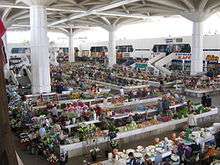
The bazaars are the heart of every town in Turkmenistan. Bazaars are usually open daily 08:00-20:00 including Sundays. Large markets, like the Tolkuchka Bazaar in the outskirts of Ashgabat are open two or three mornings per week only. Bazaars outside Ashgabat will be closed at daylight hours during the cotton harvest season in autumn. Government shops are closed on Sundays and at lunch time.
Why not add to your own despotic library by adding Turkmenbashi's self-penned Ruhnama book, exploring his views on what it means to be a Turkmen. Surprisingly, this is a fairly sensible read.
Rugs
Turkoman rugs are famous, tending towards rich reds with geometric patterns. Some traditional patterns are unique to each tribe, and an expert can generally identify the tribe from the shape of the medallion-like pattern elements called guls. However, it is fairly common to find a mixture; when a weaver from one tribe marries into a different tribe, she may use elements from both in her creations.
Sometimes Turkoman rugs are called "Bokhara" rugs because Bukhara in neighbouring Uzbekistan was a centre for their trade. Turkmenistan is not the only source of Turkoman rugs; Uzbekistan and northern areas of both Iran and Afghanistan have some Turkoman people. Other Afghan rugs are heavily influenced by Turkoman design and Turkoman designs are often copied in India and Pakistan; dealers may also call those rugs "Bokhara" but, while some of them are fine rugs, in general they are neither as high quality nor as valuable as real Turkoman rugs.
Today, wool is often coloured with synthetic and not with natural dyes; back in the 19th and early 20th century, this was a problem because early synthetic dyes were of low quality. Today, it is much less of an issue but some collectors still prefer natural dyes, mainly because they give better arbrash, the subtle variation in colour across a rug.
You need an export permission for carpets purchased in a bazaar or private shop. The Expert Commission on the back of the Carpet Museum in Ashgabat (phone 398879 and 398887, opening hours M-F 14:30-17:30, Sa 10:00-12:00) has to certify that the carpet is not more than 50 years old and may be exported. This costs 115 manat per square metre and can take a few days. In addition carpets exceeding 1.5 square metres are subject to an export duty of 400 manat per square metre payable in USD at the official rate of exchange at customs on departure.
Some carpet factories are run by the state owned company Turkmenhaly. If you buy a carpet in a state shop, the export fees normally are included in the price, although customs will charge a commission fee of 0.2 percent of the price of the carpet.
For an accessible (still in print and sanely priced) guide to these carpets, look for books by the California collector Dr. Murray Eiland. If you intend spending a lot, and especially if you are interested in older carpets, it may be worth looking deeper. The classic book on Turkoman rugs is Tappiseries de l'Asie Centrale by AA Bogolyubov, who was Tsarist governor of Turkmenistan, published in Russian and French in St. Petersburg in 1905. It was a limited edition and is now rare and extremely expensive (several thousand U.S. dollars). If you are passing through London, the British Museum has a copy and will let visitors browse through it. A translation (the original French plus English), Carpets of Central Asia (ISBN 978-0903580052), was published in Britain in the 1960s; it is no longer in print but can be found in libraries. On the used market, it is both much easier to find and far less expensive than the original.
Eat
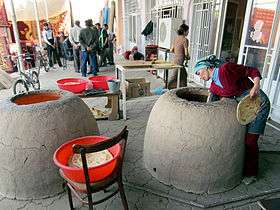
Expect distinctly average Russian cuisine in restaurants. As in Uzbekistan, plov and more central Asian-type fare can be found in markets. If you can find it, try sturgeon from the Caspian Sea, sometimes prepared in a 'tempura' style.
Meals often start with a soup, as chorba, a meat and vegetable soup. Another national dish is plov, rice with mutton, onions, carrots, spices, raisins, peas or quinces. Manty are steamed dumplings filled with lamb. Ku'urma is lamb, cooked in its own fat. Ichlekli is a meat and onion pie and gutap is a pie filled with meat, potatoes, spinach and pumpkin.
Drink
Look out for a range of 'Turkmenbashi' labeled vodka, which can be washed down with the range of Russian 'Baltika' brand beer. It can be harder to find local beers in outlets catering to foreigners, but 'Berk' is well worth asking for; 'Zip', on the other hand, is awful.
Tea is excellent and readily available.
Best to err on the side of caution, and stick with bottled water. As in Russia, you may want to specify byehz gah-zah (literally, 'without gas' or 'still; plain') if you do not like fizzy water. 'Borjomi' mineral water from Georgia is available in Ashgabat's shops.
Local people prefer to drink gok chai - green tea, often with dried fruits or herbs, as mint.
Sleep
Stay safe
Turkmenistan is safe and friendly country as long as a visitor does not discuss politics. Politics remain a very sensitive issue, and it is your responsibility that you do not involve yourself in or speak out against the government, since it is considered a crime. For safety and respect, do not under any circumstances criticise the President, the country or its people. Things have eased a bit since Turkmenbashi's death, but the country remains a tightly-controlled police state. The Ruhnama, a book written for the Turkmen people by Suparmurat Niyazov is still sold, and still learned in Turkmen schools. As such, it is best not to criticise the former President as well.
Turkmenistan, like any other Central Asian country, is a fairly corrupt country. Corrupt officials and authorities may ask for bribes, and so if you are pulled over for any reason, simply pay the bribe. It is also possible that you will be asked by police for documents. This is rather rare, but this can happen at any time and they have a legal right to do so. You should carry your passport and visa with you, though in practice, it is better to make a colour scan of the first two pages of your passport and your visa before you arrive. Carry the colour copies with you when you're walking around, and keep the original documents in the hotel safe. Also, upon arrival make a copy of your visa page. The scanned documents will almost always suffice. If not, make it clear to the Police that he will have to come to your hotel to see the originals. Nevertheless, policemen will demand a bribe for this. Always be polite with the police, but also be firm. Although rare, police can take visitors/locals to secluded places to beat up people for even more money, so stay alert. Police are the most frequent problem you will always come up across and be warned that they are generally very aggressive, especially during the night, expect some harassment from them. Many hotels, including very good ones, are frequently bugged by the police. Do not sign any documents provided by the police if it is in a language you do not know, as it may be that they may try to rip you off for some more money. Just be polite with them, and just say that you do not understand it.
A curfew prevents people from leaving from 23:00, and this law applies to non-residents as well. Going out will get you arrested. Taking taxis or hiring private drivers may avoid problems, but don't be too dependent on this option, as it is possible it may not save your life.
It is possible to take photographs relatively freely in Turkmenistan. However, you are best advised to exercise caution when photographing anyone in uniform or government buildings. In Ashgabat, there are uniformed police/military on every street corner. Play it safe early on in your visit to give yourself an idea of what is acceptable. There are almost no 'no photo signs'. If you are in doubt ask the next policeman if you are allowed to take a picture.
It should not be necessary for your guide to accompany you if you wish to leave your hotel, and go for a wander. If you are male, try to not walk with a female companion - police may think of this of walking with a prostitute and can simply arrest you.
Most taxis are not regulated by any government licensing agency and drivers are usually private citizens looking to make money. The majority of cars will not have seat belts or other safety devices, and drivers may not have had any formal driver training. For safety reasons, visitors should strongly consider hiring a private car and driver through their travel agency or hotel.
Penalties for breaking the law can be severe. Homosexual activities, prostitution and intercourse with prostitutes are prohibited, for example homosexuality is punishable by 2 years in prison.
Stay healthy
.jpg)
Vaccinations against diphtheria, tetanus, polio, hepatitis A and B are recommended. A vaccination against typhus is also recommended in case you stay in poor hygienic conditions, and a course of 3 vaccinations against rabies is recommended for long term stays and frequent contact with animals or if you are not able to get to a clinic to be treated within 18 hours of being bitten.
Medical supply does not correspond to American or European standards. Bring the medicines you need for your personal use with you, as they will be unavailable outside of Ashgabat. A travel insurance covering hospital care and an emergency flight to your home country is strictly recommended.
Avoid drinking tap water. Tap Water in Turkmenistan is known to contain traces of toxic metals, and this can cause long-term health problems.
Fruits and vegetables should be peeled before consumption. Avoid dairy products as they are not pasteurized.
Respect
Because of the nation's history (past and current), Turkmen avoid talking politics, and you should too. Turkmens are notoriously xenophobic—not in a hostile way, but in a suspicious and wary way, no doubt a product of having had to stay guarded from any attention from the secret police over the past century. To win friends, it's best to keep opinions to yourself, and let them take the lead in conversation, ideally complemented with a little Russian vodka.
